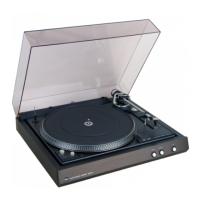
Do you have a question about the Dual CS 626 and is the answer not in the manual?
| Drive | Direct drive |
|---|---|
| Speeds | 33 1/3 and 45 RPM |
| Output voltage | 4 mV |
| Frequency response | 20 Hz - 20 kHz |
| Weight | 7.5 kg |
| Tonearm | Ultra Low Mass (ULM) tonearm |
| Platter | 1.4 kg, non-magnetic |
Lists current, line voltage, drive, power input, and power consumption.
Details platter speed, pitch control, speed monitoring, and strobe sensitivity.
Specifies total wow/flutter and rumble according to DIN standards.
Covers effective length, offset angle, tracking error, bearing friction, and stylus pressure.
Mentions cartridge compatibility and overall unit weight.
Details the electronic circuit for motor control and speed regulation.
Explains the circuit responsible for the strobe light and speed indication.
Lists and describes various transistors and integrated circuits used.
Describes solenoid connection plate and front panel controls.
Shows the component layout of the motor electronics board.
Shows the component layout of the main electronic board.
Shows component layouts for solenoid and silent circuits.
Guides for motor replacement and adjusting nominal speeds.
Explains stroboscope use for speed checking and pitch control.
Details methods for removing the tonearm and its components.
Instructions for properly adjusting the tonearm bearings.
Guide for cartridge installation and anti-skating adjustment.
Describes cue control operation and muting switch adjustment.
Details control cams and levers for automatic tonearm movement.
Explains automatic/manual start, and continuous play modes.
Describes stopping and automatic shut-off functions.
Adjusting tonearm set-down point and lifting height.
Guide for setting the correct play for the power switch slide.
How to adjust the stroke of pull magnets for start/stop operations.
How to adjust the stroke of pull magnets for lifting the tonearm.
Lists part numbers, quantities, and descriptions for replacement parts.
Lists components for various circuit boards.
Visual representation of component placement for assembly.
Visual representation of main unit components and their assembly.
Guidance on where and how to lubricate unit parts with recommended lubricants.
